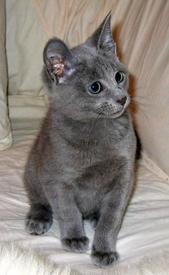
Much conjecture surrounds the history of the Russian Blue, with some being based in fact, and the rest being purely myth. It is generally accepted that the Russian Blue hails from North Russia and the Archangel Isles, where it was transported aboard ships destined for Europe in the 1800s. Because of the cat’s striking appearance, many that were wealthy and noble favoured the breed, leading it to be recognised as a cat of royalty. Rumour has it that the Russian Czar owned a Russian Blue, just as Queen Victoria did following her first encounter with one at the Crystal Palace cat show in 1875. During WWII breeding stock was greatly diminished and the Russian Blue was nearly lost; it was thanks to the careful breeding efforts of a group of American enthusiasts (who initially out-crossed the Siamese) that the breed did not disappear altogether.
The Russian Blue is often mistaken for the Chartreux, the Korat or a blue British Shorthair. Boasting a blue-grey double coat that is silver-tipped and soft to the touch, the Russian Blue is an appealing cat to look at and is well suited to the cold climes from whence it originates. Further characteristic traits include a long body, slender legs, wide-spaced ears that are round-tipped, slightly oblique green eyes and a tapering nose. The Russian Blue is almost identical to the Nebelung in everything but coat length. A cat with keen hunting instincts and capable of climbing to great heights, the Russian Blue is both sturdy and agile and reflects its wild ancestors.
Owners, breeders and enthusiasts describe the Russian Blue as a lively and humorous cat that is full of life and character. Although the Russian Blue is highly active, it can adapt well to being housed exclusively indoors which is something most owners will favour because of the breed’s rarity. Sometimes described as possessing more canine rather than feline tendencies, the Russian Blue is an affectionate and gentle cat with a huge capacity for love and loyalty. It is often the case that a Russian Blue will bond well with its immediate family, whilst remaining indifferent towards strangers. Generally speaking, a healthy Russian Blue will weigh 12 pounds, with a typical life expectancy of 12-15 years.
The Russian Blue is a very healthy and resilient breed with a long life expectancy. No genetic or breed-specific health conditions are documented in the breed, although cases of bladder stones are seen.








My cat is so gentle,specially playful,lives attention ,but not from strangers,Im so lucky that I found it as a kitten near my apartment building.
From Sir Benfro, United Kingdom
We had our girl at a very young age her mum was a bit feral and got killed don't no how. She was found with 2 kittens. We think they were 4 maybe 5 weeks old. Took some feeding her as she didn't like to be held very much. She's very play full. She's grown to be such a pretty girl. Still dosnt like to be handled. She will sit on your lap on her terms but you have to have a cushion on your legs for her to sit on. She won't settle there though but she is so pretty and we love her.